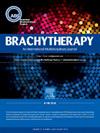PSMA PET/CT patterns of recurrence after mono-brachytherapy in men with low and intermediate prostate cancer and subsequent management
IF 1.7
4区 医学
Q4 ONCOLOGY
引用次数: 0
Abstract
PURPOSE
Brachytherapy as monotherapy is a recommended treatment option for men with low to intermediate risk prostate cancer. Local recurrence is difficult to identify. This study investigated PSMA PET/CT for recurrence after brachytherapy, as well as their subsequent management when recurrence occurred only within the prostate.
METHODS
We performed a retrospective single-center analysis for patients who were treated with brachytherapy as monotherapy for prostate cancer from May 2002 to May 2021 and who underwent a PSMA PET/CT for BCR. We report the findings on PSMA PET/CT, quantitative parameters, as well as the later management of the patients.
RESULTS
Forty patients were identified, who underwent PSMA PET/CT to investigate a rising PSA at a median (IQR) of 7 years (3.0–10.8) after initial therapy. Median (IQR) PSA at time of PSMA PET/CT was 6.54 ng/mL (3.9–15.5). On PSMA PET/CT, 20/40 (50%) men had prostate-only recurrence. Of the 20 patients with prostate-only recurrence, 8/20 (40%) had recurrence in a high-dose radiation zone, versus 7/20 (35%) in an under-covered zone. On PSMA PET/CT, recurrence within the prostate had median (IQR) SUVmax 10.4 (5.1–15.7) and volume 2.9 mL (2.0–11.2). Subsequent management of these patients with local recurrence included surveillance followed by ADT (9/20, 45%). For those with surveillance followed by ADT, the mean time before introduction of ADT was 4.1 years (range 1–8 years).
低度和中度前列腺癌男性单近距离放射治疗后复发的 PSMA PET/CT 模式及后续处理。
目的:近距离放射治疗作为一种单一疗法,是中低风险前列腺癌男性患者的推荐治疗方案。局部复发很难确定。本研究调查了近距离治疗后复发的 PSMA PET/CT 以及仅在前列腺内复发时的后续处理:方法:我们对 2002 年 5 月至 2021 年 5 月期间接受近距离放射治疗作为前列腺癌单一疗法并接受 PSMA PET/CT 检测 BCR 的患者进行了单中心回顾性分析。我们报告了 PSMA PET/CT 的结果、定量参数以及患者的后期治疗情况:结果:40 名患者在接受初次治疗后 7 年(3.0-10.8 年)接受了 PSMA PET/CT 检查,以了解 PSA 的上升情况。PSMA PET/CT 时的 PSA 中位数(IQR)为 6.54 纳克/毫升(3.9-15.5)。在 PSMA PET/CT 中,20/40(50%)名男性仅有前列腺复发。在 20 名仅前列腺复发的患者中,8/20(40%)的复发位于高剂量辐射区,而 7/20(35%)的复发位于覆盖不足区。在 PSMA PET/CT 上,前列腺内复发的 SUVmax 中位数(IQR)为 10.4(5.1-15.7),体积为 2.9 mL(2.0-11.2)。对这些局部复发患者的后续治疗包括监测和 ADT(9/20,45%)。在进行监视后再进行 ADT 治疗的患者中,采用 ADT 治疗前的平均时间为 4.1 年(1-8 年不等)。
本文章由计算机程序翻译,如有差异,请以英文原文为准。
求助全文
约1分钟内获得全文
求助全文
来源期刊

Brachytherapy
医学-核医学
CiteScore
3.40
自引率
21.10%
发文量
119
审稿时长
9.1 weeks
期刊介绍:
Brachytherapy is an international and multidisciplinary journal that publishes original peer-reviewed articles and selected reviews on the techniques and clinical applications of interstitial and intracavitary radiation in the management of cancers. Laboratory and experimental research relevant to clinical practice is also included. Related disciplines include medical physics, medical oncology, and radiation oncology and radiology. Brachytherapy publishes technical advances, original articles, reviews, and point/counterpoint on controversial issues. Original articles that address any aspect of brachytherapy are invited. Letters to the Editor-in-Chief are encouraged.
 求助内容:
求助内容: 应助结果提醒方式:
应助结果提醒方式:


